Science in Everyday Life | Term 1 Chapter 4 | 5th Science - Questions with Answers | 5th Science : Term 1 Unit 4 : Science in Everyday Life
Chapter: 5th Science : Term 1 Unit 4 : Science in Everyday Life
Questions with Answers
Science in Everyday Life ( Term 1 Chapter 4 | 5th Science )
Evaluation
I.
Choose the correct answer.
1. Blue appearance of the sky is
due to__________ of light.
a.
reflection
b.
refraction
c.
interference
d.
scattering
Answer: d. scattering
2. Who is known as Missile Man of
India?
a.
Sir. C.V.Raman
b.
Dr. A.P.J. Abdul Kalam
c.
Dr. M.S. Swaminathan
d.
Ramanujan
Answer: b. Dr. A.P.J. Abdul
Kalam
3. An example for reversible change
is
a.
melting of ice
b.
burst of balloon
c.
burning paper
d.
change of milk into curd
Answer: a. melting of ice
4. Chemical reactions are example
for
a.
reversible change
b.
irreversible change
c.
both of them
d.
none of them
Answer: b. irreversible
change
5. Which of the following is not an
organic waste?
a.
Flowers
b.
Vegetables
c.
Fruits
d.
Battery
Answer: d. Battery
II.
Fill in the blanks.
1. The book ‘Wings of fire‛ was written
by Dr. A.P.J.
Abdul Kalam.
2.
A stretched rubber band comes back to normal shape. It is an example for reversible change.
3.
Most of the physical changes are reversible changes.
4.
News paper is a recyclable waste.
5.
Wastes from house and apartments are called household waste.
III.
Match the following.
1.
Bud to flower - Dr. A.P.J. Abdul Kalam
2.
Reversible change - Recyclable waste
3.
India 2020 - Organic waste
4.
Paper - Melting of ice
5.
Vegetables - Irreversible change
Answer:
1. Bud to flower - Irreversible change
2. Reversible change- Melting of ice
3. India 2020- Dr. A.P.J. Abdul Kalam
4. Paper - Recyclable waste
5. Vegetables- Organic waste
IV.
Circle the odd one.
1.
a) Melting b) Freezing c) Boiling d) Cooking
2.
a)
Boiling b) Burning c) Cooking d) Rusting of iron
3.
a) Vegetables b) Flowers c) Fruits d) Chemicals
4.
a) Paper b) Glass c) Metals d) Paints
V.
Answer briefly.
1. Sky appears blue in colour. Why?
Blue is scattered more. Because of
this reason, sky appears blue most of the time.
2. What is reversible change?
Changes which can be reversed are
called reversible changes.
3. Differentiate reversible and
irreversible changes.
Changes which cannot be reversed are
called irreversible changes. If we bum a piece of paper it bums and turns into ash.
It cannot become paper again. This is an irreversible change. Changes which can
be reversed are called reversible changes. When water is cooled it becomes ice.
When ice is heated it becomes water. This is an example for reversible change.
4. What are the different types of
wastes?
Waste is any substance which is
discarded after primary use. It is worthless, defective and of no use. They are
unwanted and undesirable materials.

5. Write a note on e-waste.
e-wastes: Computer parts, Electronic
materials, Cell phone parts, CFL bulbs.
6. Name the scientists from Tamil
Nadu?
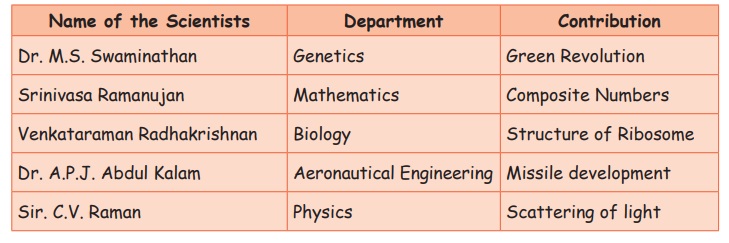
VI.
Answer in detail.
1. Write about different household
wastes.
Household Wastes: Waste from home is
known as household waste. Solid wastes disposed from home and apartments
comprise garbage and rubbish (bottles, cans, clothings, composts, disposable
items, food packings, news papers, magazines and trimmings). We can classify
the household wastes as below.
Organic wastes: Kitchen wastes,
Vegetables, Flowers, Leaves, Fruits.
Toxic wastes: Old medicines,
Paints, Chemicals, Bulbs, Spray cans, Fertilizers, Pesticide containers,
Batteries, Shoe polish.
Recyclable wastes : Paper, Glass,
Metals, Plastics.
Solid wastes: Clothes soiled with blood and
other body fluids.
e-wastes: Computer parts, Electronic
materials, Cell phone parts, CFL bulbs.
2. Expalin the need for waste
disposal.
To control pollution : Various
pollutions like water pollution, air pollution and soil pollution can be avoided.
To conserve natural resources ; Waste
disposal is important for the conservation of our environmental resources like
forest, minerals and water.
To control spread of diseases : Spread of infectious diseases can be controlled.
Recycle for further use : Wastes can be
recycled to get products for further use.
3. How can you reduce wastes in
your school environment?
1. A trash can should be kept in
each classroom. Students should be advised to drop waste materials only in the
trash can.
2. Each class should be divided into
squads and one squad should take over class cleaning every week.
3. Wastes should be seggregated in
biodegradable and non biodegradable and kept in appropriate containers.
4. A compost pit should be made in a
comer of the school garden and biodegradable garbage should be converted into
compost.
5. An awareness should be created
among students to keep the classrooms and school campus clean.
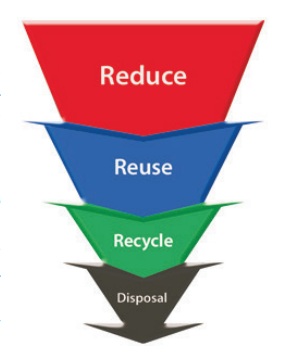
Activity 1
Take an elastic band and stretch it to the maximum. Now release it. What do you observe?
Cut it now into pieces. Can you get the band back again?
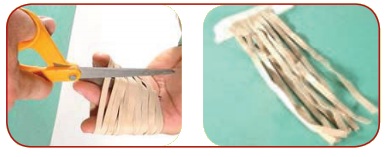
Answer: NO
Activity 2
Take a balloon and blow air into it. You can see that the shape and size of the balloon is changed. Now let the air escape from the balloon. What do you observe now?
Now blow it to its full size and prick it with the tip of a pin. It is burst. Can you get the balloon back?
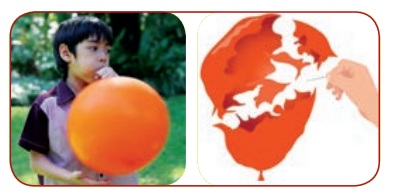
Answer: NO
Activity 3
Which of these common changes, you think, can be reversed?
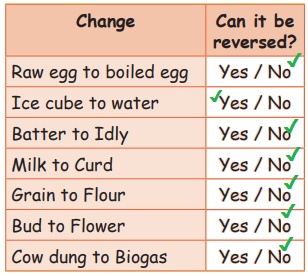
Activity 4
Collect the wastes from your house before it is thrown into dustbin. Separate them into two groups.
Group 1: Garbage from the kitchen like fruit and vegetable peel, egg shells, waste food, tea leaves, news papers, dry leaves and paper bags.
Group 2: Pieces of cloth, polythene bags, brocken glass, aluminum wrappers, nails, old shoes and broken toys.
Find out how you can dispose them properly.
Related Topics